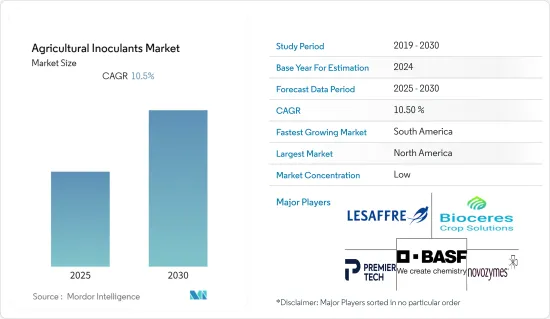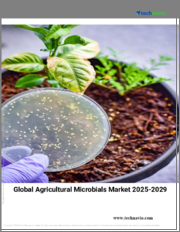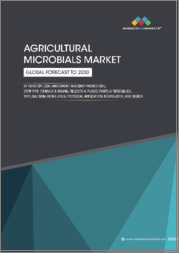
|
시장보고서
상품코드
1687066
농업용 접종제 시장 : 시장 점유율 분석, 산업 동향 및 통계, 성장 예측(2025-2030년)Agricultural Inoculants - Market Share Analysis, Industry Trends & Statistics, Growth Forecasts (2025 - 2030) |
||||||
농업용 접종제 시장은 예측 기간 동안 CAGR 10.5%를 기록할 전망입니다.

주요 하이라이트
- 현재의 농업 관행은 비료, 살충제, 제초제 등의 화학물질의 투입에 크게 의존하고 있어 농산물의 영양가 및 농업 종사자, 소비자의 건강에 악영향을 미치고 있습니다. 이러한 화학물질의 과잉하고 무차별적인 사용은 식품 오염, 잡초나 질병에 대한 내성, 환경에 악영향을 초래하여 인간의 건강에 큰 영향을 주고 있습니다. 이러한 화학 물질의 투입은 토양에 유독 화합물의 축적을 촉진합니다.
- 합성 비료 중에는 염산 라디칼이나 황산 라디칼 등의 산성 라디칼을 포함하는 것이 있으며, 토양의 산성도를 높여 토양이나 식물의 건강에 악영향을 미칩니다. 또한 난분해성이 높은 화합물은 식물에 따라 흡수될 수도 있습니다. 그러한 작물을 지속적으로 섭취하면 인간의 체계적인 장애로 이어질 수 있습니다.
- 그 때문에 질이 나쁜 작물의 소비에 의한 건강 과제에 대한 의식의 고조로부터, 인간의 건강을 해치지 않고 농산물의 양과 질을 향상시키기 위한, 새로운 개량 기술이 요구되고 있습니다.
- 화학물질 투입을 대체하는 확실한 방법으로 바이오 비료, 바이오 제초제, 바이오 농약, 바이오 방제제로 기능하는 미생물 접종제가 있습니다. 그것들은 생산성 및 작물의 건강을 개선하기 위해 토양과 식물에 사용되는 수익 미생물입니다. 또한 해충을 구제하고 땅이나 작물의 품질을 향상시키기 위해서도 널리 이용되고 있습니다.
- 게다가 유기농업의 채용을 촉진하기 위한 정부의 이니셔티브는 조사기간 동안 시장의 성장을 가속할 것으로 예상되고 있습니다. 예를 들어 그린딜의 Farm to Fork 전략 아래 유럽위원회는 2030년까지 EU 농지의 최소 25%를 유기농업 하에 두고 유기양식을 대폭 증가시킨다는 목표를 설정했습니다.
농업용 접종제 시장 동향
유기농법 및 환경친화적인 농법 채용
- 농법은 관행 농법에서 유기농법으로 이행하는 경향이 있습니다. 이러한 이행은 기존의 농법이 인간의 건강이나 환경의 안전에 미치는 악영향에 대한 의식의 고조에 기인하고 있습니다.
- 유기농업조사연구소(독일어 : Forschungsinstitut fur biologischen Landbau(FiBL)에 따르면 유기재배면적은 2018년 7,090만 ha에서 2021년에는 7,640만 ha로 증가하여 187개국이 유기농업을 실천하고 있습니다. 이 때문에 접종제와 같은 유기 솔루션에 대한 수요가 높아져 민관의 지역밀착형 연구에 대한 투자가 증가하고 있습니다.
- 미생물 접종제는 토양의 건전성을 향상시키고 영양의 이용 가능성을 높이고 질병으로부터 보호할 수 있기 때문에 합성 투입물을 대체하는 자연스럽고 지속 가능한 옵션을 제공합니다. 또한 미생물 접종제는 합성 투입물의 환경 영향을 줄이고 보다 지속 가능한 농법을 촉진하는 데 도움이 됩니다.
- 그 결과 미생물 접종제 수요는 환경 실적를 줄이고 보다 건강하고 지속 가능한 작물을 생산하는 방법을 찾고 있는 농가들 사이에서 증가하고 있습니다. 아울러 농지 면적 증가와 유기농 제품에 대한 소비자 수요 증가는 예측 기간 동안 농업용 접종제 시장에 긍정적인 영향을 줄 것으로 보입니다.
북미가 최대 시장
- 북미는 농업용 접종제의 최대 시장이며, 미국이 점유율의 대부분을 차지하고 있습니다. 고도로 발전한 농업 부문을 가진 미국은 최근 자연농법 및 유기농법을 채택하고 있습니다. 화학물질의 투입 비용의 증가, 토양량이나 환경에 대한 악영향, 균형 잡힌 식물 영양에 관한 의식의 고조가, 이 나라의 시장을 견인하는 주된 요인이 되고 있습니다.
- 게다가, 특정 기업과 연구 기관은 경쟁 우위를 얻기 위해 신제품의 도입을 중시하고 있습니다. 예를 들어 위니펙의 바이오 연구 기업 XiteBio Technologies가 개발한 XiteBio OptiPlus는 시장에서 실적이 있는 AGPT(Advanced Growth Promotion Technology)를 이용한 획기적인 대두용 액체 접종제입니다.
- 이는 질소 고정 세균 Bradyrhizobium japonicum과 2021년 2월에 캐나다에서 등록된 특허 취득이 끝난 인산 가용화 식물 성장 촉진 근립균(PGPR)을 조합한 것으로, 대두 전용으로 설계되어 있습니다. 이러한 개발은 이 지역의 농업용 접종제 수요를 창출하고 조사 기간 동안 세계 시장에 영향을 줄 것으로 예상됩니다.
농업용 접종제 산업 개요
농업용 접종제 시장은 단편화되어 있으며, 세계 기업이 주요 시장 점유율을 차지하고 있습니다. 주요 기업들은 연구개발 활동, 광범위한 제품 포트폴리오, 지리적 확대, 인수, 적극적인 프로모션 전략에 주력하며 시장에서의 지위를 유지하고 있습니다. 대기업에는 Novozymes, Lesaffre, Bioceres Crop Solutions, Premier Tech, BASFSE 등이 있습니다.
기타 혜택
- 엑셀 형식 시장 예측(ME) 시트
- 3개월간의 애널리스트 서포트
목차
제1장 서론
- 조사의 전제조건 및 시장 정의
- 조사 범위
제2장 조사 방법
제3장 주요 요약
제4장 시장 역학
- 시장 개요
- 시장 성장 촉진요인
- 유기농법 및 환경친화적인 농법의 채용
- 경작지면적 감소 및 식량안전에 대한 우려 증가
- 시장 성장 억제요인
- 기존 제품과 합성 제품에 대한 높은 수요
- 농업용 접종제의 채용을 제한하는 인식 부족 및 기타 요인
- Porter's Five Forces 분석
- 공급기업의 협상력
- 구매자 및 소비자의 협상력
- 신규 참가업체의 위협
- 대체품의 위협
- 경쟁 기업간 경쟁 관계의 강도
제5장 시장 세분화
- 기능별
- 작물 영양
- 작물 보호
- 미생물별
- 박테리아
- 근립균
- 아조토박터
- 포스호박테리아
- 기타 세균
- 균류별
- 트리코델마
- 균근균
- 기타 균류
- 기타 미생물
- 박테리아
- 시용 방법별
- 종자 접종
- 토양 접종
- 작물 유형별
- 곡물
- 콩류 및 지방종자
- 상업 작물
- 과일 및 채소
- 기타 용도
- 지역별
- 북미
- 미국
- 캐나다
- 멕시코
- 기타 북미
- 유럽
- 독일
- 영국
- 프랑스
- 스페인
- 러시아
- 이탈리아
- 기타 유럽
- 아시아태평양
- 중국
- 일본
- 인도
- 호주
- 기타 아시아태평양
- 남미
- 브라질
- 아르헨티나
- 기타 남미
- 아프리카
- 남아프리카
- 기타 아프리카
- 북미
제6장 경쟁 구도
- 가장 채용된 전략
- 시장 점유율 분석
- 기업 프로파일
- BASF SE
- Premier Tech
- Lallemond Inc.
- Novozymes
- Mapleton Agri Biotec Pty Ltd
- New Edge Microbials Pty Ltd
- T.Stanes & Company Limited
- AEA Investors(Verdesian Life Sciences LLC)
- Lesaffre
- Bioceres Crop Solutions
제7장 시장 기회 및 향후 동향
AJY 25.05.02The Agricultural Inoculants Market is expected to register a CAGR of 10.5% during the forecast period.

Key Highlights
- Current agricultural practices depend heavily on chemical inputs, such as fertilizers, pesticides, and herbicides, which cause a deleterious effect on the nutritional value of farm products and the health of farm workers and consumers. Excessive and indiscriminate use of these chemicals has resulted in food contamination, weed and disease resistance, and adverse environmental outcomes, significantly impacting human health. Applying these chemical inputs promotes the accumulation of toxic compounds in soils.
- Several synthetic fertilizers contain acid radicals, such as hydrochloride and sulfuric radicals, increasing soil acidity and adversely affecting soil and plant health. Highly recalcitrant compounds can also be absorbed by some plants. Continuous consumption of such crops can lead to systematic disorders in humans.
- Therefore, the increasing awareness of health challenges due to the consumption of poor-quality crops has led to a quest for new and improved technologies to improve the quantity and quality of produce without jeopardizing human health.
- A reliable alternative to chemical inputs is microbial inoculants that can act as biofertilizers, bioherbicides, biopesticides, and biocontrol agents. They are beneficiary microorganisms applied to the soil or the plant to improve productivity and crop health. They are also widely used to control pests and improve the quality of the ground and crops.
- Moreover, government initiatives to promote the adoption of organic farming are anticipated to fuel the market growth during the study period. For instance, under the Green Deal's Farm to Fork strategy, the European Commission set a target of at least 25% of the EU's agricultural land under organic farming and a significant increase in organic aquaculture by 2030.
Agricultural Inoculants Market Trends
Adoption of Organic and Eco-friendly Farming Practices
- Agricultural practices are witnessing a trend shift from conventional to organic farming. This shift can be attributed to growing awareness about the adverse impact of traditional farming methods on human health and environmental safety.
- According to the Research Institute of Organic Agriculture (German: Forschungsinstitut fur biologischen Landbau (FiBL)), the area under organic cultivation increased from 70.9 million ha in 2018 to 76.4 million ha in 2021, with 187 countries practicing organic agriculture. This increases the demand for organic solutions such as inoculants and investments in localized research by private and public sectors.
- Microbial inoculants offer a natural and sustainable alternative to synthetic inputs, as they can improve soil health, increase nutrient availability, and protect against diseases. Additionally, microbial inoculants help reduce the environmental impact of synthetic inputs and promote more sustainable farming practices.
- As a result, the demand for microbial inoculants is increasing among farmers looking for ways to reduce their environmental footprint and produce healthier, more sustainable crops. Moreover, rising acreage and growing consumer demand for organic products will positively influence the agricultural inoculants market during the forecast period.
North America is the Largest Market
- North America is the largest market for agricultural inoculants, with the United States holding the majority of the share. The United States, with its highly evolved agricultural sector, has been adopting the natural and organic way of farming lately. The increasing cost of chemical inputs, their adverse effect on soil mass and the environment, and increasing awareness regarding balanced plant nutrition are the major factors driving the market in the country.
- Moreover, certain companies and research institutions emphasize introducing new products to gain a competitive advantage. For instance, developed by the Winnipeg bioresearch company XiteBio Technologies, XiteBio OptiPlus is a revolutionary proprietary liquid inoculant for soybeans powered by market-proven AGPT (Advanced Growth Promoting Technology).
- It combines the nitrogen-fixing bacteria Bradyrhizobium japonicum with patented phosphate-solubilizing plant growth-promoting rhizobacteria (PGPR), registered in Canada in February 2021, designed explicitly for soybeans. Such developments are anticipated to create demand for agricultural inoculants in the region and influence the global market during the study period.
Agricultural Inoculants Industry Overview
The agricultural inoculants market is fragmented, with international players occupying a major market share. The major players focus on R&D activities, extensive product portfolios, geographical expansions, acquisitions, and aggressive promotional strategies to uphold their position in the market. Some of the leading players are Novozymes, Lesaffre, BioceresCrop Solutions, Premier Tech, and BASF SE.
Additional Benefits:
- The market estimate (ME) sheet in Excel format
- 3 months of analyst support
TABLE OF CONTENTS
1 INTRODUCTION
- 1.1 Study Assumptions and Market Definition
- 1.2 Scope of the Study
2 RESEARCH METHODOLOGY
3 EXECUTIVE SUMMARY
4 MARKET DYNAMICS
- 4.1 Market Overview
- 4.2 Market Drivers
- 4.2.1 Adoption of Organic and Eco-friendly Farming Practices
- 4.2.2 Declining Area of Arable Land and Rising Food Security Concerns
- 4.3 Market Restraints
- 4.3.1 High Demand for Conventional and Synthetic Products
- 4.3.2 Lack of Awareness and Other Factors Limiting the Adoption of Agricultural Inoculants
- 4.4 Porter's Five Forces Analysis
- 4.4.1 Bargaining Power of Suppliers
- 4.4.2 Bargaining Power of Buyers/Consumers
- 4.4.3 Threat of New Entrants
- 4.4.4 Threat of Substitute Products
- 4.4.5 Intensity of Competitive Rivalry
5 MARKET SEGMENTATION
- 5.1 Function
- 5.1.1 Crop Nutrition
- 5.1.2 Crop Protection
- 5.2 Microorganism
- 5.2.1 Bacteria
- 5.2.1.1 Rhizobacteria
- 5.2.1.2 Azotobacter
- 5.2.1.3 Phosphobacteria
- 5.2.1.4 Other Bacteria
- 5.2.2 Fungi
- 5.2.2.1 Trichoderma
- 5.2.2.2 Mycorrhiza
- 5.2.2.3 Other Fungi
- 5.2.3 Other Microorganisms
- 5.2.1 Bacteria
- 5.3 Mode of Application
- 5.3.1 Seed Inoculation
- 5.3.2 Soil Inoculation
- 5.4 Crop Type
- 5.4.1 Grains and Cereals
- 5.4.2 Pulses and Oilseeds
- 5.4.3 Commercial Crops
- 5.4.4 Fruits and Vegetables
- 5.4.5 Other Applications
- 5.5 Geography
- 5.5.1 North America
- 5.5.1.1 United States
- 5.5.1.2 Canada
- 5.5.1.3 Mexico
- 5.5.1.4 Rest of North America
- 5.5.2 Europe
- 5.5.2.1 Germany
- 5.5.2.2 United Kingdom
- 5.5.2.3 France
- 5.5.2.4 Spain
- 5.5.2.5 Russia
- 5.5.2.6 Italy
- 5.5.2.7 Rest of Europe
- 5.5.3 Asia-Pacific
- 5.5.3.1 China
- 5.5.3.2 Japan
- 5.5.3.3 India
- 5.5.3.4 Australia
- 5.5.3.5 Rest of Asia-Pacific
- 5.5.4 South America
- 5.5.4.1 Brazil
- 5.5.4.2 Argentina
- 5.5.4.3 Rest of South America
- 5.5.5 Africa
- 5.5.5.1 South Africa
- 5.5.5.2 Rest of Africa
- 5.5.1 North America
6 COMPETITIVE LANDSCAPE
- 6.1 Most Adopted Strategies
- 6.2 Market Share Analysis
- 6.3 Company Profiles
- 6.3.1 BASF SE
- 6.3.2 Premier Tech
- 6.3.3 Lallemond Inc.
- 6.3.4 Novozymes
- 6.3.5 Mapleton Agri Biotec Pty Ltd
- 6.3.6 New Edge Microbials Pty Ltd
- 6.3.7 T.Stanes & Company Limited
- 6.3.8 AEA Investors (Verdesian Life Sciences LLC)
- 6.3.9 Lesaffre
- 6.3.10 Bioceres Crop Solutions



















